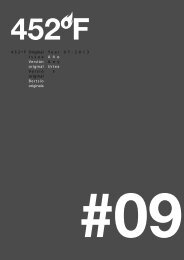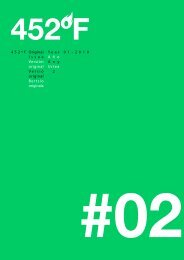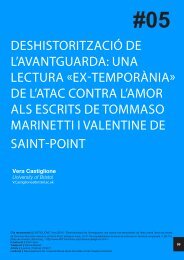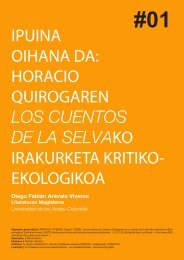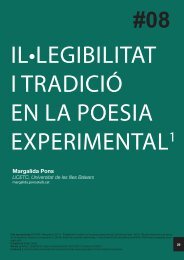03 - 452ºF
03 - 452ºF
03 - 452ºF
You also want an ePaper? Increase the reach of your titles
YUMPU automatically turns print PDFs into web optimized ePapers that Google loves.
0. Introduction<br />
In this paper I want to explore the idea of métissage – a kind of<br />
intertextuality – as it’s been theorized by Françoise Lionnet (1989)<br />
through a close reading of Le Cow-boy (1983), an autobiographical<br />
novel by Djanet Lachmet about the Algerian Revolution (1954 – 1962).<br />
Lionnet describes métissage as a textual weaving of traditions in<br />
order to reintroduce oral Creole customs and to re-evaluate received<br />
Western concepts. The term implies the process of creolization (from<br />
the French word «métis», referring to persons of racially-mixed blood).<br />
It is etymologically linked to «tissage», the French for «weaving»,<br />
and provides a metaphor for the construction of narratives. Besides<br />
being a concept, métissage is also a praxis and a site of purposeful<br />
ambiguity: «Métissage is […] the site of undecidability and<br />
indeterminacy, where solidarity becomes the fundamental principle<br />
of political action against hegemonic languages» (Lionnet, 1989: 6).<br />
The term thus carefully links issues of race, politics, reading and<br />
writing. Described by literary critics Mohammed Tabti and Christiane<br />
Achour as autobiographical or as a life-story, Djanet Lachmet’s only<br />
novel was published in France by Pierre Belfond in 1983 (see Tabti,<br />
2001, Achour and Ali-Benali, 1991). Not much is known about the<br />
author—the reverse side of her book states only that she was born<br />
in Algeria and lives in Paris. She is described by Michel Laronde as<br />
part of the «Mouvance beure», originating in Paris (698). After a bit<br />
of research, I also discovered that she is an actor who starred in<br />
independent films like L’Autre France (1975), directed by Algerian<br />
film director Ali Ghalem. The novel was translated into English by<br />
Judith Still and published under the title Lallia in 1987. While the<br />
translation brought the book to a wider readership, Still has been<br />
criticized for her translation; especially her decision to convert the<br />
narrative’s present tense into a series of confusing past tenses. For<br />
this reason, the translations I provided here are my own. Le Cow-boy<br />
is told in a mixture of first and third-person voices and describes the<br />
anguishes and difficulties of an Algerian girl confronted with racism,<br />
class tensions and the cruelties of war. The title of the novel implies<br />
the overarching plot – a Romeo and Juliet theme – in which an<br />
Algerian Muslim girl loves a French boy, nicknamed the «Cowboy».<br />
Their young love does not end with their double suicide, however,<br />
but is doomed by the madness of the war around them, the loyalties<br />
mandated by their families and the multiple factions of the armed<br />
nationalist movement. Written in French prose, Lachmet’s novel<br />
reels from childhood memories to love letters to wild hallucinations<br />
to ancestral tales. The youthful voice of the protagonist describes her<br />
tumultuous childhood in exuberant run-on sentences in the present<br />
tense, rupturing the narrative with flashbacks and abrupt scene<br />
changes. It is clear from the beginning of the story that Lallia has<br />
a tenuous relationship with her parents and sister—especially with<br />
«Je suis un cowboy du Far West»: A study of textual métissage in Djanet Lachmet’s autobiographical novel Le Cow-boy (1983) - Caroline Kelley<br />
<strong>452ºF</strong>. #<strong>03</strong> (2010) 85-101.<br />
87



